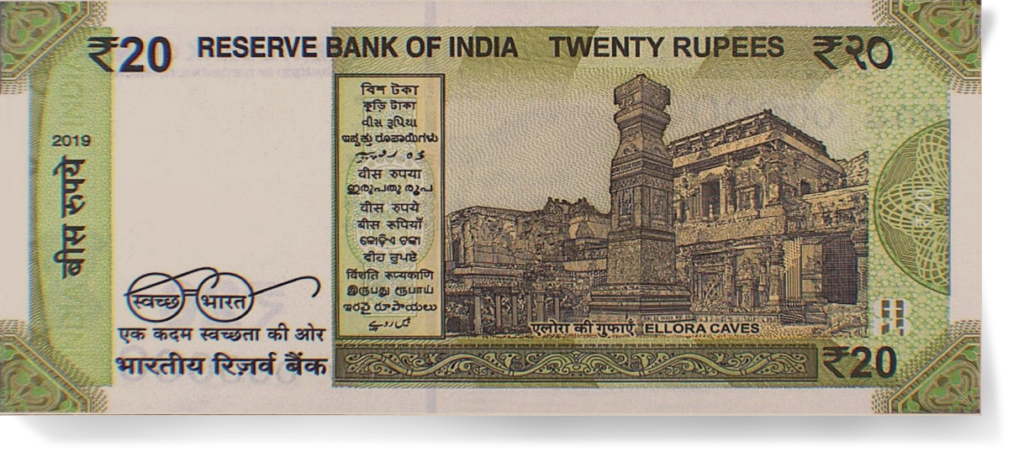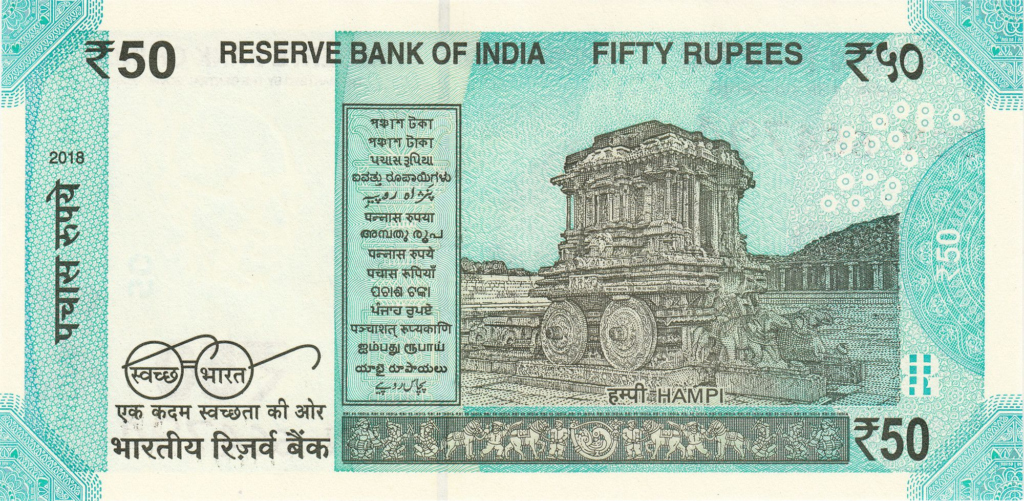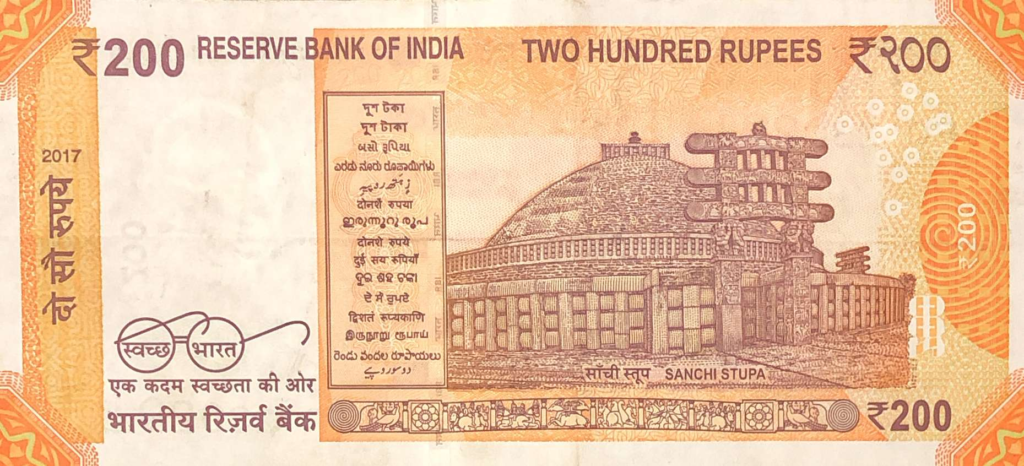The currency notes in India aren’t just a medium to purchase goods. The currency notes also throw light on the rich heritage of country. All the currency notes, currently in circulation in India, talk about different monuments in the country. Let’s have a look at them.
Rs 10 note : Sun Temple, Konark, Odisha

The 10 Rupees note showcases wheel from Surya Temple, Konark, Odisha. Konark Sun Temple is a 13th-century temple at Konark in Odisha. The temple is attributed to king Narasimhadeva I of the Eastern Ganga dynasty about 1250 CE.
What remains of the temple complex has the appearance of a 100-foot (30 m) high chariot with immense wheels and horses, all carved from stone. Once over 200 feet (61 m) high, much of the temple is now in ruins. The large shikara tower over the sanctuary; at one time rose much higher than the mandapa that remains. The structures and elements that have survived are famed for their intricate artwork, iconography, and themes, including erotic kama and mithuna scenes. Also called the Surya Devalaya, it is a classic illustration of the Odisha style of Architecture or Kalinga architecture.
The cause of the destruction of the Konark temple is unclear and still remains a source of controversy and conspracies. Theories range from natural damage to deliberate destruction of the temple in the course of being sacked several times by Muslim armies between the 15th and 17th centuries. This temple was called the “Black Pagoda” in European sailor accounts as early as 1676 because it looked like a great tiered tower which appeared black. Similarly, the Jagannath Temple in Puri was called the “White Pagoda”. Both temples served as important landmarks for sailors in the Bay of Bengal. The temple that exists today was partially restored by the conservation efforts of British India-era archaeological teams. Declared a UNESCO World Heritage Site in 1984, Konark Surya Mandir is one of the emost popular tourist destinations in Odisha.
20 Rs Note: Ellora Caves, Ellora (Verul), Maharashtra

The 20 Rs note depicts a picture of the courtyard from Kailash temple of Ellora caves situated in Chhatrapati Sambhajinagar district (previously called as Aurangabad) of Maharashtra. The Dhwajastambha exiting in tis courtyard can be very clearly seen on the photograph on the currency.
The Kailasha or Kailashanathatemple is the largest of the rock-cut Hindu temples at the Ellora Caves. A megalith carved from a cliff face, it is considered one of the most remarkable cave temples in the world because of its size, architecture, and sculptural treatment. It is also world’s largest monolith structure.
The Kailasa temple (Cave 16) is the largest of the 34 Hindu, Buddhist, and Jain cave temples and monasteries known collectively as the Ellora Caves, ranging for over two kilometres along the sloping basalt cliff at the site. Most of the excavation of the temple is generally attributed to the eighth century Rashtrakuta king Krishna I (r. c. 756 – 773), with some elements completed later. The temple architecture shows traces of Pallava and Chalukya styles. The temple contains a number of relief and free-standing sculptures on a grand scale equal to the architecture, though only traces remain of the paintings which originally decorated it.
The Kailasa temple architecture is different from the earlier style prevalent in the Deccan region. It appears to be based on the Virupaksha Temple at Pattadakal and the Kailasa temple at Kanchi, but it is not an exact imitation of these two temples. The southern influence on the temple architecture can be attributed to the involvement of Chalukya and Pallava artists in its construction. The indigenous Deccan artisans appear to have played a subordinate role in the temple’s construction.
50 Rs Note: Stone Chariot, Hampi, Karnataka

The 50 Rs note represents a photo of famous stone chariot from Vijay Vitthala temple or Vitthala temple, situated at Hampi.
The Vitthala temple is situated over 3 kilometres north-east of the Virupaksha temple; another famous landmark in Hampi. It is located near the banks of the Tungabhadra River. It is unclear when the temple complex was built, and who built it. Most scholars date it to a period of construction in the early-to-mid-16th century. Some of the books mention that its construction began during the time of Devaraya II and continued during the reign of Krishnadevaraya, Achuytaraya, and probably Sadasivaraya and it stopped due to the destruction of the city in 1565. The inscriptions include male and female names, suggesting that the complex was built by multiple sponsors. The temple was dedicated to Vitthala, a form of Krishna also called Vithoba.
The Vitthala temple has a Garuda shrine in the form of a stone chariot in the courtyard; it is an often-pictured symbol of Hampi. Above the chariot is a tower, which was removed during 1940s, as per historian Dr.S.Shettar. The Garuda shrine is a Vahana Mandapa, a common feature in Dravidian temple architecture. The temple is also quite well known for the musical pillars. The pillars from the Mahamandapa of the temple produce musical notes when tapped gently. The unique phenomenon is most commonly attributed to the purposefully created hallow cavities in the pillars.
A common folklore about this temple connects it to the famouls Vitthala shrine at Pandharpur in Maharashtra. The folklore suggests that the Vithoba idol earlier existed at this temple. It was shifted from here during the Islamic invasions; and placed at a safe location far away in Pandharpur. The idol started to be worshipped there in later period.
100 Rs Note : Rani ki Vav, Patan, Gujarat

The 100 Rs note showcases the picture of Rani ki Vav, one of the most famous stepwells in the country.
Rani Ki Vav (lit. ’The Queen’s Stepwell’) is a stepwell situated in the town of Patan in Gujarat. It is located on the banks of the Saraswati River. Its construction is attributed to Udayamati, the spouse of the 11th-century Chaulukya king Bhima I. Silted over, it was rediscovered in the 1940s and restored in the 1980s by the Archaeological Survey of India. It has been listed as one of the UNESCO World Heritage Sites in India since 2014. This stepwell is designed as an inverted temple highlighting the sanctity of water. It is divided into seven levels of stairs with sculptural panels. These panels have more than 500 principal sculptures and over 1000 minor ones combining religious, secular, and symbolic imagery.
Rani ki vav is considered to be one of the finest and largest examples of stepwell architecture in Gujarat. It was built at the height of craftsmens’ ability in stepwell construction and the Maru-Gurjara architecture style, reflecting mastery of this complex technique and a beauty of detail and proportions. The architecture and sculptures are similar to the Vimalavasahi temple on Mount Abu and Sun temple at Modhera.
It is classified as a Nanda-type stepwell. The stepwell is divided into seven levels of stairs, which lead down to a deep, circular well. A stepped corridor is compartmentalized at regular intervals with pillared, multistorey pavilions. The walls, pillars, columns, brackets and beams are ornamented with carvings and scrollwork. The niches in the side walls are ornamented with delicate figures and sculptures.
While stepwells are a common structure in many parts of the country, the building style differs from region to region. The stepwell at Patan (Rani ki Vav), Adalaj (Adalaj ni vav) and Abhaneri (Chand Baoli) are visited by tourists more often than the others.
200 Rs Note: Sanchi Stupa, Sanchi, Madhya Pradesh

The currency note of 200 Rs consists of a picture of the famous Stupa at Sanchi. The Torana at the entrance of stupa can very clearly be seen.
Sanchi Stupa is a Buddhist complex, famous for its Great Stupa, on a hilltop at Sanchi Town in Raisen District of the State of Madhya Pradesh. The monuments at Sanchi today comprise a series of Buddhist monuments starting from the Mauryan Empire period (3rd century BCE), continuing with the Gupta Empire period (5th century CE), and ending around the 12th century CE. It is probably the best preserved group of Buddhist monuments in India. The oldest, and also the largest monument, is the Great Stupa also called Stupa No. 1, initially built under the Mauryans, and adorned with one of the Pillars of Ashoka. During the following centuries, especially under the Shungas and the Satavahanas, the Great Stupa was enlarged and decorated with gates and railings, and smaller stupas were also built in the vicinity.
Simultaneously, various temple structures were also built, down to the Gupta Empire period and later. Altogether, Sanchi encompasses most of the evolutions of ancient Indian architecture and ancient Buddhist architecture in India, from the early stages of Buddhism and its first artistic expression, to the decline of the religion in the subcontinent.
19th Century Europeans were very much interested in the Stupa which was originally built by Ashoka. French sought the permission to take away the eastern gateway to France. English, who had established themselves in India, majorly as a political force, were interested too in carrying it to England for a museum. They were satisfied with plaster-cast copies which were carefully prepared and the original remained at the site, part of Bhopal state.
Today, around fifty monuments remain on the hill of Sanchi, including three main stupas and several temples. The monuments have been listed among other famous monuments in the UNESCO World Heritage Sites since 1989. The reliefs of Sanchi, especially those depicting Indian cities, have been important in trying to imagine what ancient Indian cities look like. Many modern simulations are based on the urban illustrations of Sanchi.
500 Rs Note : Red Fort, Delhi

The 500 Rs note depicts a picture of Red fort situated at Delhi.
The Red Fort or Lal Qila is a historic fort in the Old Delhi neighbourhood of Delhi, that historically served as the main residence of the Mughal emperors. Emperor Shah Jahan commissioned construction of the Red Fort on 12 May 1639, when he decided to shift his capital from Agra to Delhi.
The fort was plundered of its artwork and jewels during Nader Shah’s invasion of the Mughal Empire in 1739. Most of the fort’s marble structures were subsequently demolished by the British following the Indian Rebellion of 1857. The fort’s defensive walls were largely undamaged, and the fortress was subsequently used as a garrison.
On 15 August 1947, the first Prime Minister of India, Jawaharlal Nehru, raised the Indian flag above the Lahori Gate. Every year on India’s Independence Day (15 August), the prime minister hoists the Indian tricolour flag at the fort’s main gate and delivers a nationally broadcast speech from its ramparts through the Public Address System of Indian Army Corps of Signals. The Red Fort, the largest monument in Delhi, is one of its most popular tourist destinations and attracts thousands of visitors every year.
Interesting Facts about the representation
- The representation of monuments on currency notes maintains a geographical balance. We have monument from North (Red fort), East (Konark temple), South (Hampi), West (Rani ki vaav and Ellora caves) and central India (Sanchi Stupa).
- The representation also tries to strike a religious balance. Red fort was built by Muslim rules, Sanchi Stupa is a Buddhist monument, temples at Konark and Hampi are Hindu temples, Ellora caves are mis of Hindu, Buddhist and Jain iconography.
- The purpose of monuments are also different for each. Red fort is fort; Konark temple and Hampi temple are temples; Raani ki Vaav is a stepwell used for water management; Ellora caves are rock cut caves and Sanchi Stupa is a Buddhist Stupa.
- Every monument represented on currency note is either a UNESCO World Heritage Site, or part of a group that is UNESCO World Heritage Site.
